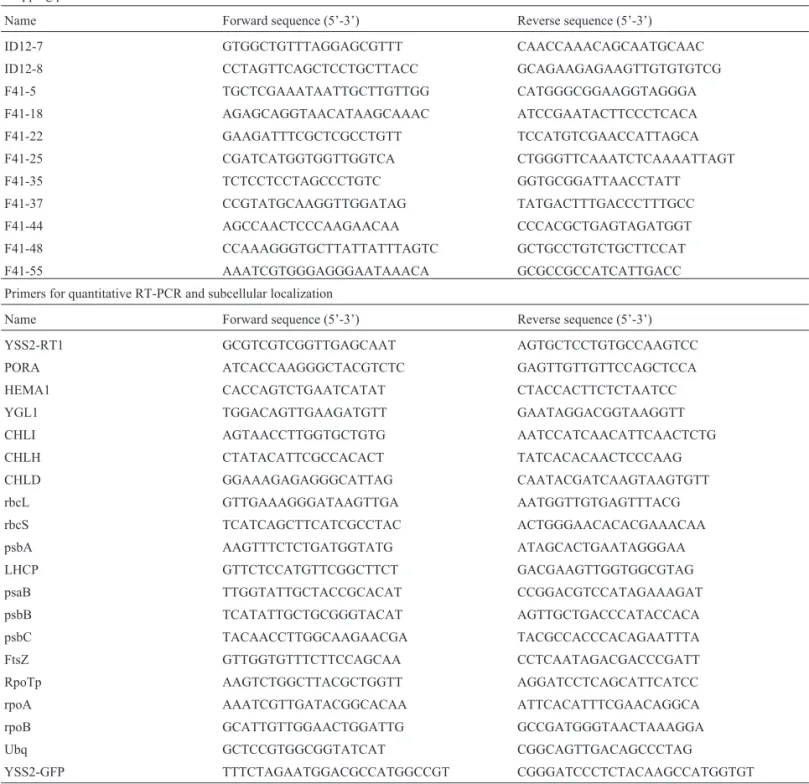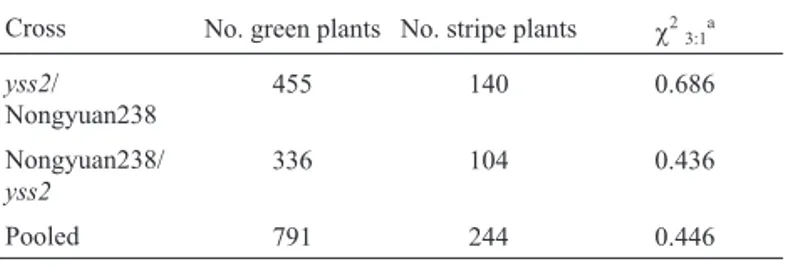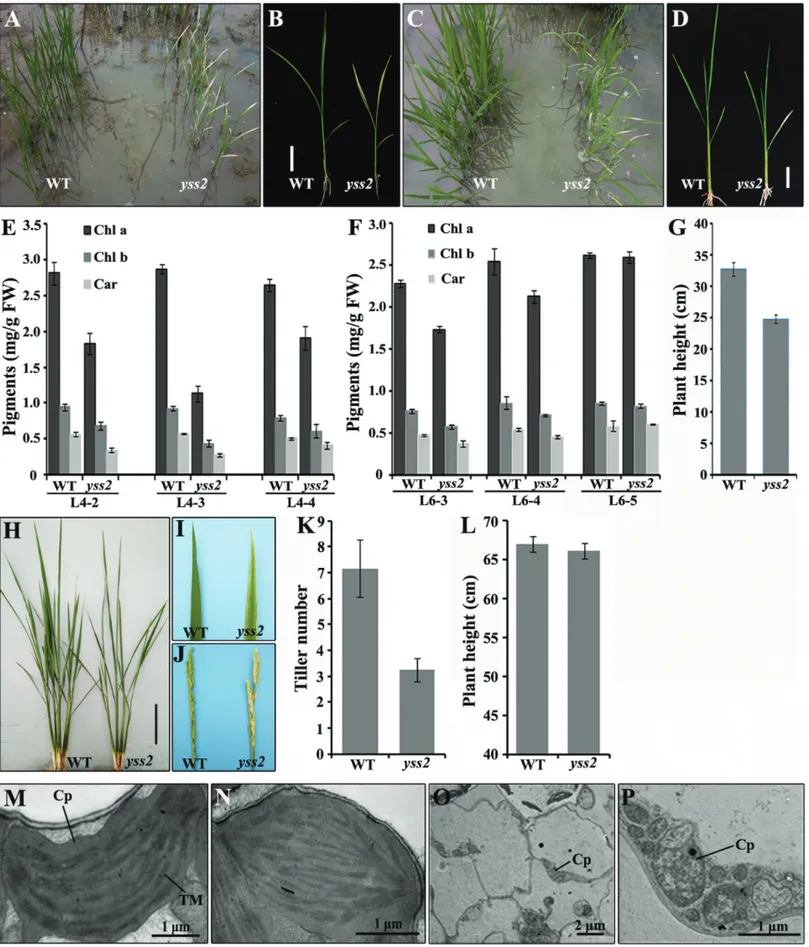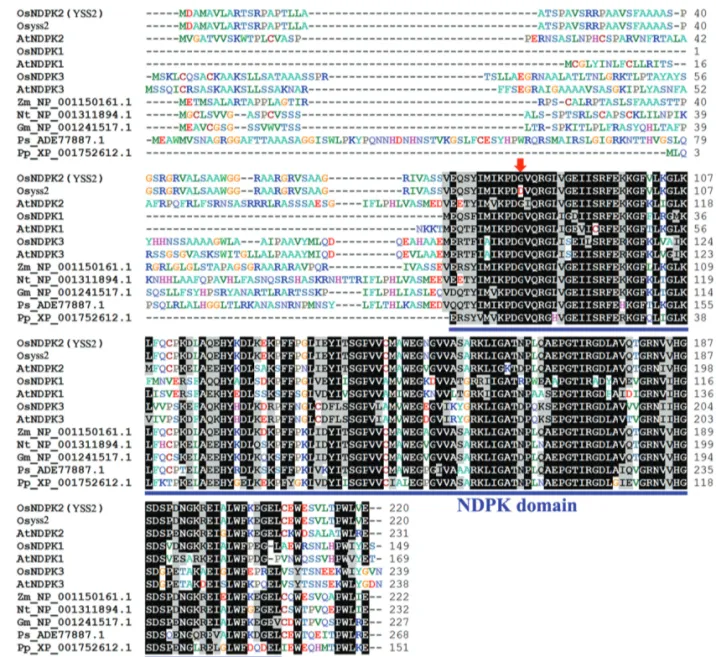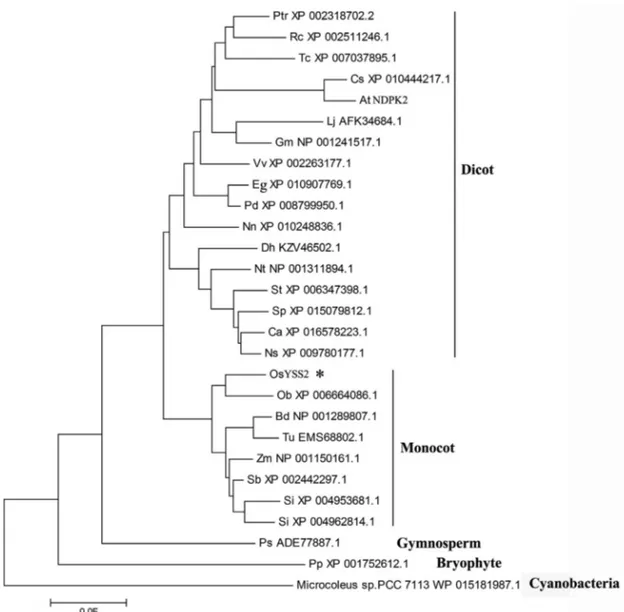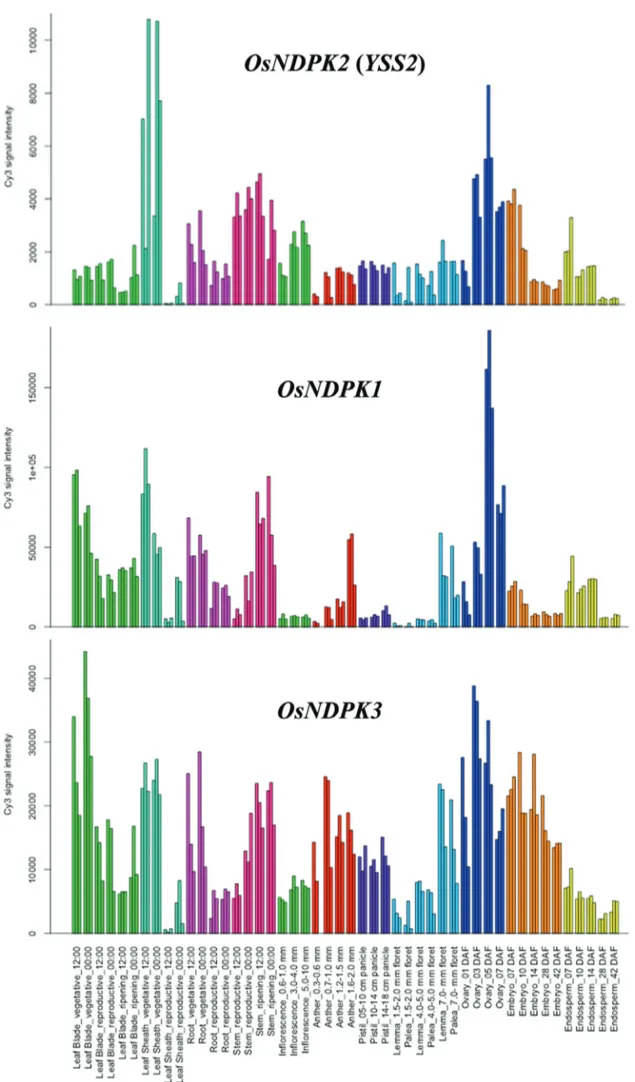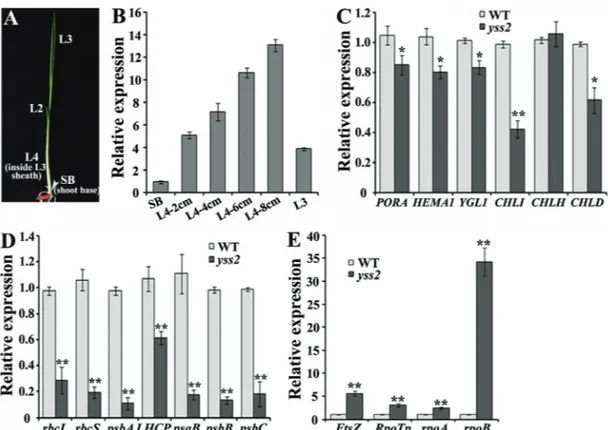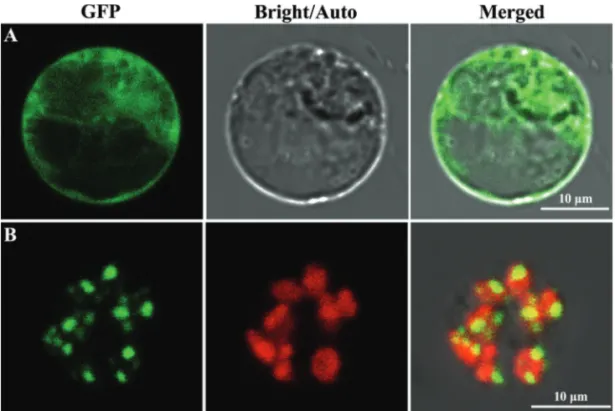A
Young Seedling Stripe2
phenotype in rice is caused by mutation of a
chloroplast-localized nucleoside diphosphate kinase 2 required for chloroplast
biogenesis
Kunneng Zhou
1, Jiafa Xia
1, Yuanlei Wang
1, Tingchen Ma
1and Zefu Li
11
Key laboratory of Rice Genetics and Breeding, Rice Research Institute, Anhui Academy of
Agricultural Sciences, Hefei, P.R. China
Abstract
Chloroplast development and chlorophyll (Chl) biosynthesis in plants are regulated by many genes, but the underly-ing molecular mechanisms remain largely elusive. We isolated a rice mutant namedyss2 (young seedling stripe2) with a striated seedling phenotype beginning from leaf 2 of delayed plant growth. The mutant developed normal green leaves from leaf 5, but reduced tillering and chlorotic leaves and panicles appeared later. Chloroticyss2 seed-lings have decreased pigment contents and impaired chloroplast development. Genetic analysis showed that the mutant phenotype was due to a single recessive gene. Positional cloning and sequence analysis identified a single nucleotide substitution inYSS2 gene causing an amino acid change from Gly to Asp. The YSS2 allele encodes a NDPK2 (nucleoside diphosphate kinase 2) protein showing high similarity to other types of NDPKs. Real-time RT-PCR analysis demonstrated thatYSS2 transcripts accumulated highly in L4 sections at the early leaf develop-ment stage. Expression levels of genes associated with Chl biosynthesis and photosynthesis inyss2 were mostly de-creased, but genes involved in chloroplast biogenesis were up-regulated compared to the wild type. The YSS2 protein was associated with punctate structures in the chloroplasts of rice protoplasts. Our overall data suggest that YSS2 has important roles in chloroplast biogenesis.
Keywords: Chloroplast biogenesis, NDPK,Oryza sativa, positional cloning,YSS2gene.
Received: October 12, 2016; Accepted: March 30, 2017.
Introduction
Chloroplasts are essential organelles in higher plants. The formation of a mature chloroplast from a proplastid during plant development involves many steps: first, the development of the chloroplast itself followed by the devel-opment of a functional photosynthetic apparatus (Mullet, 1993; Sakamotoet al., 2008). There are about 3,000 nu-clear-encoded and nearly 120 plastid-encoded chloroplast proteins in higher plants (Timmiset al., 2004; Reumannet al., 2005; Pfalz and Pfannschmidt, 2013). These proteins play important roles in chloroplast development, photosyn-thesis and plastid transcription (Sakamoto et al., 2008; Donget al., 2013; Pfalz and Pfannschmidt, 2013; Zhouet al., 2013, 2017). Chloroplast biogenesis from proplastids to mature chloroplast goes through three steps (Kusumiet al., 2010): first, plastid DNA synthesis and plastid division, second, establishment of the plastid transcription/transla-tion apparatus, a key to chloroplast formatranscription/transla-tion, and third, ac-tivation of the photosynthetic apparatus. At the molecular
level, transcript accumulations from both nuclear and plastid genes are necessary for all three steps (Kusumiet al., 2010).FtsZ(encoding a component of the plastid divi-sion machinery) is required for the first step (TerBushet al., 2013);RpoTp,rpoAandrpoB, separately encoding NEP, and PEP and subunits, respectively, are highly ex-pressed during the second step (Hricováet al., 2006; Stei-neret al., 2011; Börneret al., 2015), andrbcS(encoding the small subunit of ribulose-1,5-bisphosphate carboxylase),
rbcL(encoding the large subunit of ribulose-1,5-bisphos-phate carboxylase) andpsbA(encoding the D1 subunit of the PSII complex) are abundant in the third step, which functions in activation of the photosynthetic apparatus (Hwang and Tabita, 1989; Nelson and Yocum, 2006). Chloroplast development is affected by alterations in ex-pression levels of these genes. Similarly,V1,V2,V3,St1
andVYLtranscripts were reported to accumulate highly in the first or second steps of chloroplast differentiation and to be required for chloroplast biogenesis (Sugimoto et al., 2004, 2007; Yooet al., 2009; Kusumiet al., 2011; Donget al., 2013).
Chl-deficient mutants are ideal materials to study Chl biosynthesis, chloroplast development, and chloroplast DOI: http://dx.doi.org/10.1590/1678-4685-GMB-2016-0267
Send correspondence to Zefu Li. Key laboratory of Rice Genetics and Breeding, Rice Research Institute, Anhui Academy of Agricul-tural Sciences, 40 South Road of Nongke, Hefei, 230031, P.R. China. E-mail: lizefu@aliyun.com.
RNA editing.OsYGL1encodes a Chl synthase that cata-lyzes esterification of chlorophyllide, the last step of Chl biosynthesis (Wuet al., 2007). Knockdown of theYGL2
gene, which encodes heme oxygenase 1, hinders Chl bio-synthesis in rice (Chen et al., 2013; Liet al., 2013). A chloroplast PPR protein was encoded by the WSL gene, which regulated the splicing ofrpl2transcript. In thewsl
mutant, PEP-dependent plastid gene expression was obvi-ously down-regulated, and plastid rRNAs synthesis and plastid translation efficiency were reduced. These led to the aberrant chloroplast development and sensitive response of the mutant to abiotic stress (Tanet al., 2014).YSS1encodes a chloroplast nucleoid protein, which was characterized as an important regulator of PEP activity. Decreased accumu-lation ofYSS1transcripts disrupted Chl biosynthesis and chloroplast differentiation (Zhou et al., 2017). OsWLP1
(encoding a chloroplast ribosome L13 protein) andOsWP1
(encoding Val-tRNA synthetase) play essential roles in chloroplast development of leaf and panicle. Weak allele mutation inWLP1caused albino seedling phenotype and bleached panicles, especially severe under lower tempera-ture. Chloroplast development could be affected in the seedlings and young panicles ofwlp1mutant, although data are not available (Songet al., 2013). Single nucleotide tran-sitions inOsWP1lead to a severe albino phenotype (wp1
died after the L4 stage) or a virescent phenotype (wp1
showed striated leaf in seedlings and white panicles at heading). Thewp1mutant arrested plastidic protein synthe-sis and biogenesynthe-sis of chloroplast ribosomes and was defec-tive in early chloroplast development (Wanget al., 2016). In addition,YSA,YLC1, andAM1were also implicated in Chl biosynthesis and chloroplast formation in different ways (Suet al., 2012; Zhouet al., 2013; Shenget al., 2014). NDPKs, which are among the oldest proteins and widely present in various prokaryotes and eukaryotes, mainly function in maintaining the metabolic balance be-tween NTPs and NDPs in cells (Hasunumaet al., 2003). They also have essential roles in cell growth and division, signal transduction and plant stress response (Zimmermann
et al., 1999; Moonet al., 2003; Ryuet al., 2005; Dorionet al., 2006). Three kinds of NDPKs predominate in higher plants. NDPK1 is a cytoplasm-associated protein whereas NDPK2 and NDPK3 are separately localized in plastids and mitochondria (Bolteret al., 2007; Kiharaet al., 2011). Different localizations suggest that NDPKs play important roles in different cell compartments. Previous studies dem-onstrated that NDPK2 is associated with embryo and seed development and involved in response to external stress (Yano et al., 1995; Nato et al., 1997; Kawasaki et al., 2001). However, there is little reported evidence that NDPK2 participates in chloroplast development and Chl biosynthesis.
In this study, we aimed to characterize a young seed-ling stripe mutant,yss2. The mutant showed a striated phe-notype from leaf 2 to leaf 4 and a normal leaf phephe-notype
thereafter. Plant growth was also delayed and there were fewer tillers per plant than in the wild type. The chlorotic leaf phenotype is associated with decreased pigment levels and aberrant chloroplasts. At heading stage, the uppermost leaves are slightly chlorotic and immature panicles display a degree of whitening. We showed that the symptoms were caused by a mutation in a single gene locus that was fine-mapped to a 62.4 kb region in chromosome 12. Sequence analysis demonstrated that a single base mutation had oc-curred in the gene we named as YSS2and subsequently showed to encode a nucleoside diphosphate kinase 2 (NDPK2) with high similarity to NDPKs in other species. Expression analysis showed that YSS2 was highly ex-pressed in L4 tissues, the key time of chloroplast bio-genesis. Subcellular localization showed that YSS2 is a chloroplast-associated protein. These results implied that
YSS2plays important roles in chloroplast biogenesis.
Materials and Methods
Plant materials and growth conditions
The white leaf and panicle mutantyss2was identified in an MNU-mutagenized population of japonica cultivar Nongyuan 238. Plants were grown in a growth chamber or paddy fields. Crosses between theyss2mutant and Non-gyuan 238 or Nanjing 11 were separately used for genetic analysis and gene mapping. Seeds of cultivars Nongyuan 238 and Nanjing 11 were obtained from the Chinese Na-tional Key Facility for Crop Gene Resources and Genetic Improvement in Beijing.
Determination of pigment contents
Chls and Car were assayed spectrophotometrically according to methods described previously (Zhouet al., 2013). Leaf samples were collected from second, third, fourth or fifth leaves at the L4 or L6 growth stages and sep-arately marinated in 95% ethanol for 48 h in darkness. Absorbance of supernatants was measured with a DU 800 UV/Vis Spectrophotometer (Beckman Coulter) at 665, 649 and 470 nm.
Transmission electron microscopy (TEM)
Leaf samples were prepared for TEM from green and white sections of third leaves inyss2mutant and from simi-lar positions of wild type at the fully expanded L3 stage. Transverse sections of leaves were fixed in a solution of 2.5% glutaraldehyde and then incubated in 1% OsO4
Mapping ofYSS2
Following initial mapping of theYSS2locus between Indel/SSR markers ID12-8 and RM3331 on chromosome 12 using 35 F2mutant segregants, an additional 1,216 F2
plants with striated leaf phenotype were used for fine-mapping. High-density Indel markers were developed based on sequence differences between cv. Nipponbare ( ja-ponica) and 93-11 (indica). Primer pairs designed with Primer Premier 5.0 are listed in Table 1. Full-length cDNA and genomic DNA of the predicted ORFs in wild type and
yss2mutant were amplified and sequenced.
Quantitative real-time RT-PCR
Total RNA was extracted from wild-type and yss2
seedlings using an RNA Prep Pure Plant kit (Tiangen) and reverse-transcribed using a SuperScript II kit (TaKaRa). Real-time RT-PCR was performed using a SYBR®Premix Ex TaqTMkit (TaKaRa) on a LightCycler 480 Real-Time PCR System (Roche). The 2-CTmethod was used to ana-lyze relative gene expression (Livak and Schmittgen, 2001). Primers for real-time RT-PCR (YSS2-RT1, PORA, HEMA1, YGL1, CHLI, CHLH, CHLD, rbcL, rbcS, psbA, LHCP, psaB, psbB, psbC, FtsZ, RpoTP, rpoA and rpoB), listed in Table 1, were designed by GenScript
Table 1- Primer sequences used in this study.
Mapping primers
Name Forward sequence (5’-3’) Reverse sequence (5’-3’)
ID12-7 GTGGCTGTTTAGGAGCGTTT CAACCAAACAGCAATGCAAC
ID12-8 CCTAGTTCAGCTCCTGCTTACC GCAGAAGAGAAGTTGTGTGTCG
F41-5 TGCTCGAAATAATTGCTTGTTGG CATGGGCGGAAGGTAGGGA
F41-18 AGAGCAGGTAACATAAGCAAAC ATCCGAATACTTCCCTCACA
F41-22 GAAGATTTCGCTCGCCTGTT TCCATGTCGAACCATTAGCA
F41-25 CGATCATGGTGGTTGGTCA CTGGGTTCAAATCTCAAAATTAGT
F41-35 TCTCCTCCTAGCCCTGTC GGTGCGGATTAACCTATT
F41-37 CCGTATGCAAGGTTGGATAG TATGACTTTGACCCTTTGCC
F41-44 AGCCAACTCCCAAGAACAA CCCACGCTGAGTAGATGGT
F41-48 CCAAAGGGTGCTTATTATTTAGTC GCTGCCTGTCTGCTTCCAT
F41-55 AAATCGTGGGAGGGAATAAACA GCGCCGCCATCATTGACC
Primers for quantitative RT-PCR and subcellular localization
Name Forward sequence (5’-3’) Reverse sequence (5’-3’)
YSS2-RT1 GCGTCGTCGGTTGAGCAAT AGTGCTCCTGTGCCAAGTCC
PORA ATCACCAAGGGCTACGTCTC GAGTTGTTGTTCCAGCTCCA
HEMA1 CACCAGTCTGAATCATAT CTACCACTTCTCTAATCC
YGL1 TGGACAGTTGAAGATGTT GAATAGGACGGTAAGGTT
CHLI AGTAACCTTGGTGCTGTG AATCCATCAACATTCAACTCTG
CHLH CTATACATTCGCCACACT TATCACACAACTCCCAAG
CHLD GGAAAGAGAGGGCATTAG CAATACGATCAAGTAAGTGTT
rbcL GTTGAAAGGGATAAGTTGA AATGGTTGTGAGTTTACG
rbcS TCATCAGCTTCATCGCCTAC ACTGGGAACACACGAAACAA
psbA AAGTTTCTCTGATGGTATG ATAGCACTGAATAGGGAA
LHCP GTTCTCCATGTTCGGCTTCT GACGAAGTTGGTGGCGTAG
psaB TTGGTATTGCTACCGCACAT CCGGACGTCCATAGAAAGAT
psbB TCATATTGCTGCGGGTACAT AGTTGCTGACCCATACCACA
psbC TACAACCTTGGCAAGAACGA TACGCCACCCACAGAATTTA
FtsZ GTTGGTGTTTCTTCCAGCAA CCTCAATAGACGACCCGATT
RpoTp AAGTCTGGCTTACGCTGGTT AGGATCCTCAGCATTCATCC
rpoA AAATCGTTGATACGGCACAA ATTCACATTTCGAACAGGCA
rpoB GCATTGTTGGAACTGGATTG GCCGATGGGTAACTAAAGGA
Ubq GCTCCGTGGCGGTATCAT CGGCAGTTGACAGCCCTAG
(https://www.genscript.com/ssl-bin/app/primer). The
ubiquitingene (LOC_Os03g13170) (Ubq) was used as a reference control.
Sequence and phylogenetic analysis
Candidate genes were predicted by the RGAP data-base
(http://rice.plantbiology.msu.edu/cgi-bin/gbrowse/rice/). Homologous sequences of YSS2 were identified using the
blastp search mode at NCBI
(http://www.ncbi.nlm.nih.gov/) and sequences were aligned with BioEdit software. A neighbor-joining tree based on 1,000 bootstrap replicates was generated using MEGA v4.1 software. Expression profiles of YSS2,
OsNDPK1 (LOC_Os07g30970) and OsNDPK3
(LOC_Os05g51700) were obtained from the RiceXPro da-tabase (http://ricexpro.dna.affrc.go.jp/). Subcellular local-ization of YSS2 was predicted using the ChloroP (Emanuelssonet al., 1999) and TargetP (Emanuelsson et al., 2000) programs.
Subcellular localization
The coding sequence of YSS2 was amplified and cloned to the N-terminus of GFP in the transient expression vector pA7-GFP (primer pairs shown in Table 1). Fusion plasmid YSS2-GFP and free GFP were separately trans-formed into rice protoplasts and incubated in darkness at 28 °C for 16 h before examination (Chiuet al., 1996; Chen
et al., 2006; Zhouet al., 2013, 2017). GFP fluorescence was observed with a confocal laser scanning microscope (Carl Zeiss LSM700).
Results
Phenotypic characterization of theyss2mutant
Theyss2mutant was originated from an N
-methyl-N-nitrosourea (MNU) mutagenized population ofjaponica
cultivar (cv.) Nongyuan 238. The mutant seedlings dis-played a striated leaf phenotype in seedling leaves 2 to 4 un-der paddy field conditions (Figure 1A,B). However, the fifth and later leaves had normal green phenotype (Figure 1C,D). Theyss2mutant showed delayed seedling growth compared to wild type (Figure 1A-D). To further character-ize the mutant, we determined the pigment levels of chlo-rotic leaves at the four- and six-leaf stages. These leaves had reduced Chl a, Chl b and Car contents relative to the wild type (Figure 1E,F). However, from leaf 5 there was no obvious difference from wild type (Figure 1F). The height ofyss2seedlings was less than the wild type (Figure 1A-D, G). At the maximum tillering stage, theyss2mutant was phenotypically similar to wild type except for reduced height (Figure 1H). The yss2 mutant later developed a slight chlorotic leaf phenotype and white panicles at head-ing, but plant height was restored to the wild-type level (Figure 1I-L).
To investigate the effect ofyss2on chloroplast devel-opment we compared the ultrastructures of chloroplasts in
yss2 mutant and wild type seedlings using TEM. The chloroplasts of green sections (basal section) ofyss2leaves had well-developed lamellar structures with normally stacked grana and thylakoid membranes similar to wild type plants (Figure 1M,N); however, chloroplasts in the white segments were undifferentiated (Figure 1O,P). Col-lectively, our data showed that theyss2mutation caused a chlorotic defect that disrupted chloroplast development and delayed seedling growth.
Cloning of theYSS2gene
For genetic analysis of the YSS2 locus, reciprocal crosses betweenyss2mutant and Nongyuan 238 were made to determine the mode of inheritance of theyss2phenotype. F1plants showed the wild type phenotype, and the F2
popu-lations segregated 3 green : 1 stripe (Table 2). Thus theyss2
phenotype was caused by a single recessive nuclear gene. A mapping population was generated from cross
yss2/ Nanjing 11. Thirty-five F2 individuals with typical yss2striated characteristics were used to map theYSS2 lo-cus to a 5.4 Mb region between markers ID12-8 and RM3331 on chromosome 12L (Figure 2A). With 1,216 ho-mozygous F2mutant individuals we narrowed the region to
a 62.4 kb interval between Indel markers F41-37 and F41-55 (Figure 2B). The interval contained ten ORFs and the genes within it were predicted using the RGAP database (http://rice.plantbiology.msu.edu/) (Figure 2C, Table 3). Sequence analysis showed that the eighth ORF (designated nucleoside diphosphate kinase; LOC_Os12g36194) in the
yss2mutant carried a single nucleotide change (G to A) in the second exon relative to wild type, resulting in an amino acid change from Gly to Asp at position 83 (Figure 2D,E). To verify the mutation in theYSS2gene, 15 green and five striated seedlings from theyss2/ Nanjing11 F2population
were sequenced and examined for presence of Gly or Asp at position 83. All five striated individuals carried only Asp, the four green seedlings carried only Gly, and the other 11 green seedlings were heterozygous, carrying both Gly and Asp. This provided evidence that the amino acid change was responsible for the mutant phenotype.
Table 2- Segregation of green and striated seedlings in F2populations from two crosses.
Cross No. green plants No. stripe plants 23:1a
yss2/ Nongyuan238
455 140 0.686
Nongyuan238/
yss2
336 104 0.436
Pooled 791 244 0.446
a
Figure 2- Positional cloning of theYSS2gene. (A) Theyss2locus was mapped to a 5.4 Mb region between Indel/SSR markers ID12-8 and RM3331 on chromosome 12L. (B) Theyss2locus was narrowed to a 62.4 kb interval between Indel markers F41-37 and F41-55 using 1,216 F2homozygous mutant plants. (C) Ten ORFs were predicted in the region. (D) Schematic of ORF8 structure. ATG and TAA represent the start and stop codons, respectively.
Gray boxesindicate 5’ and 3’ UTR.Black boxesandlinesbetween them separately indicate exons and introns. The NDPK domain is indicated. Theyss2
mutant has a single G to D change in the eighth ORF. The mutation site is indicated by a red arrowhead. The single nucleotide change led to a Gly (G) to Asp (D) substitution. (E) Chromatograms from sequencing of wild type andyss2genomic DNA.Black frameindicates the mutation site
Table 3- Gene prediction within the 62.4 kb region delimited by markers.
Gene Orientation Annotation
LOC_Os12g36120 Forward Retrotransposon protein, putative
LOC_Os12g36130 Forward Expressed protein
LOC_Os12g36140 Reverse Retrotransposon protein, putative
LOC_Os12g36150 Reverse Retrotransposon protein, putative
LOC_Os12g36160 Reverse Expressed protein
LOC_Os12g36170 Reverse HEAT repeat family protein, putative
LOC_Os12g36180 Reverse Auxilin, putative
LOC_Os12g36194 Forward Nucleoside diphosphate kinase, putative
LOC_Os12g36210 Reverse Inhibitor I family protein, putative
YSS2encodes nucleoside diphosphate kinase 2
TheYSS2allele with seven exons and six introns en-codes a polypeptide of 220 amino acid residues with a pre-dicted molecular mass of 23.5 kDa (Figure 2D). The predicted structure indicated that the YSS2 protein con-tained an NDPK domain covering amino acid residues 73–207 (Figure 3). The YSS2 protein exhibited high simi-larity to NDPK superfamily proteins in other species across a region of nearly 150 amino acids in the C-terminus. Se-quence alignment showed that the Gly83site is highly con-served in NDPK proteins (Figure 3), suggesting that the site has an essential role.
Phylogenetic analysis revealed that YSS2-like pro-teins broadly exist in many photosynthetic organisms and likely evolved from the cyanobacteria to angiosperms, thereby forming a large subclade, in which orthologs from
monocots and dicots are clearly separated (Figure 4). This suggests that YSS2 is an evolutionarily conserved protein evolved from prokaryotic to eukaryotic genomes.
Gene expression analysis
The expression profiles ofOsYSS2,OsNDPK1 and
OsNDPK3were predicted using the Rice Expression Pro-file Database.YSS2was expressed in various organs at dif-ferent growth stages with higher levels in leaf sheaths, stems and ovaries. Overall expression levels were lower than for other NDPKs (Figure 5).OsNDPK1was mostly expressed in flag leaves, leaf sheaths and roots at the vege-tative stage and in stems and ovaries at flowering.
OsNDPK3was highly expressed in all tissues at different developmental stages (Figure 5).
Figure 3- Amino acid sequence alignment of YSS2-related proteins. Conserved residues are shaded. Sequences are for OsNDPK2/YSS2 (Oryza sativa, LOC_Os12g36194), Osyss2 (the mutated YSS2 protein), AtNDPK2 (Arabidopsis thaliana, At5g63310), OsNDPK1 (Oryza sativa, LOC_Os07g30970), AtNDPK1 (Arabidopsis thaliana, NP_567346.1), OsNDPK3 (Oryza sativa, LOC_Os05g51700), AtNDPK3 (Arabidopsis thaliana, At4g11010),Zea maysNP_001150161.1,Nicotiana tabacumNP_001311894.1,Glycine maxNP_001241517.1,Picea sitchensisADE77887.1,Physcomitrella patens
To investigate the expression profile ofYSS2during the process of chloroplast biogenesis, we detected theYSS2
transcripts in different sections of wild type seedlings at the L3 stage. TheYSS2accumulated more in L4 tissues than in leaf 3 and shoot base, and the expression levels were gradu-ally increased with the elongation of leaf 4 (Figure 6A,B). The data revealed thatYSS2was highly expressed in the second step of chloroplast biogenesis.
Given the phenotypic difference between the yss2
mutant and wild type seedlings, we compared the expres-sion levels of genes associated with Chl biosynthesis, pho-tosynthesis and chloroplast biogenesis. Expression levels of Chl biosynthesis-related genes, such asPORA(encoding NADPH-dependent protochlorophyllide oxidoreductase),
HEMA1(encoding glutamyl tRNA reductase),YGL1 (en-coding Chl synthetase),CHLI andCHLD(encoding Mg-chelatase I and D subunits) were clearly decreased inyss2
seedlings compared to wild type. However, there was no difference in expression ofCHLH(encoding Mg-chelatase
H subunit) (Figure 6C). Expression of genes involved in photosynthesis, such asrbcLandrbcS(encoding large and small subunits of Rubisco),psbA,psbBandpsbC(encoding PSII subunits), LHCP (encoding PSII-associated light-harvesting chlorophyll protein) and psaB (encoding PSI subunit) was distinctly down-regulated in the mutant (Fig-ure 6D). Genes required for the first (FtsZ, encoding a com-ponent of the plastid division machinery) and second (RpoTP, rpoA and rpoB, separately encoding NEP, and PEP and subunits) steps of chloroplast biosynthesis were up-regulated in theyss2mutant compared to wild type (Figure 6E). These data suggested that theYSS2is involved in the regulatory network of Chl biosynthesis and photo-synthesis as well as chloroplast formation.
Subcellular localization of YSS2
TargetP (Emanuelsson et al., 2000) and ChloroP (Emanuelssonet al., 1999) softwares predicted that YSS2
localizes to chloroplasts and contains a chloroplast-tar-geting signal of 68 amino acid residues. To detect the actual localization of YSS2, free GFP and YSS2-GFP fusion pro-teins were each transiently expressed in rice protoplasts. Confocal microscopy confirmed that free GFP was dis-persed in the cytoplasm (Figure 7A), whereas YSS2-GFP co-localized with Chl autofluorescence and displayed punctate structures (Figure 7B). The data showed that YSS2 is a chloroplast-associated protein.
Discussion
A number of Chl-deficient and chloroplast develop-ment-associated mutants were recently identified in rice. Some of them show chlorotic phenotypes in young seed-lings or young leaves and later develop normally, such as
ysa,ylc1,yss1andwsl(Suet al., 2012; Zhouet al., 2013, 2017; Tanet al., 2014). However, some mutants (ygl1and
vyl) display the mutant phenotype and delayed plant growth throughout the entire life cycle (Wuet al., 2007; Donget al., 2013). This contrasted with theam1mutant that also exhibited a chlorotic leaf phenotype throughout the life cy-cle but with little effect on plant development (Shenget al., 2014). The ygl2 or grc1 mutants showed yellow-green seedling leaf phenotypes but gradually reverted to almost normal green leaves from the tillering stage; both mutants showed delayed plant growth (Chenet al., 2013; Liet al.,
2013). wp1 and wlp1 mutants both displayed chlorotic leaves accompanied by white panicles. The relatively weak
wp1mutant had a virescent phenotype and developed white panicles (Wanget al., 2016). Thewlp1 mutant produced albinic leaves until the four-leaf stage but became green at L4 and thereafter; a white panicle appeared at heading (Songet al., 2013). The present white leaf and panicle mu-tantyss2showed a striated/chlorotic phenotype at L2, L3 and L4, but normal green leaves at leaf 5 and thereafter. The normal leaf phenotype inyss2persisted until maximum till-ering, somewhat likewlp1 mutant, a slight chlorotic leaf phenotype developed along with white panicles (Figure 1H-K). The chlorotic phenotype presented in young seed-lings and panicles suggested thatYSS2might play key roles in young tissues. Genes associated with plastid transcrip-tion/translation were largely regulated in wlp1 mutant (Songet al., 2013). Similarly,wp1impaired chloroplast ri-bosome biogenesis and reduced plastidic protein synthesis (Wanget al., 2016). We observed thatyss2mutant has phe-notypes in seedlings and panicles similar towp1andwlp1, suggesting thatYSS2might function at the plastid transcrip-tion and translatranscrip-tion stages, but further studies are needed for confirmation.
YSS2was mapped to a 62.4 kb interval on chromo-some 12L and 10 ORFs were predicted in the region (Fig-ure 2A-C). Genomic sequence analysis revealed that the
only change in the mutant was in the 8thORF ofYSS2and was a single base mutation causing an amino acid substitu-tion of Gly by Asp at posisubstitu-tion 83 (Figure 2D,E).YSS2was highly expressed in the second step of chloroplast bio-genesis, indicating thatYSS2might directly participate in chloroplast formation. Subcellular localization showed that YSS2 is a chloroplast-associated protein (Figure 7B). These data implied that the yss2 mutation might hinder chloroplast biogenesis during early leaf and panicle devel-opment, leading to the chlorotic phenotype in young seed-lings and panicles. However, we cannot rule out the possibility thatYSS2also has important roles in develop-ment of other types of plastids. This is supported by the fact thatYSS2is expressed in non-green tissues (Figure 5). Al-though there was delayed plant growth and reduced height at the seedling stage the eventual plant height at maturity was similar to the wild type (Figure 1G,L), suggesting that
YSS2paralogs sufficiently compensate for YSS2 function at some growth stages. Expression analysis showed that the housekeeping genes (rpoAand rpoB) and photosynthetic genes (such asrbcL,psbAandpsaB) were separately up-and down-regulated inyss2mutant (Figure 6B,C), suggest-ing that yss2 might decrease PEP activity and suppress plastid transcription. The dramatically elevated levels of
rpo genes and decreased expression of photosynthetic genes indicated that the mutants lacked chloroplast ribo-somes or reduced plastid DNA contents (Hesset al., 1993; Udyet al., 2012). We also observed that genes involved in Chl biosynthesis and chloroplast biogenesis were differ-ently regulated (Figure 6C-E), implying thatYSS2might have important roles in the regulatory network of both.
Nevertheless, the reduced expression of genes for Chl biosynthesis is not strong and could be an indirect effect such as retrograde plastid-to-nucleus signaling that disturbs the expression of nuclear-encoded chloroplast genes (Mochizukiet al., 2001; Nottet al., 2006).
It has been reported that NDPKs regulate the meta-bolic balance between NTPs and NDPs by catalyzing the transfer of phosphate groups and are involved in cell growth and division, embryo and seed development, signal transduction and plant stress response (Yanoet al., 1995; Natoet al., 1997; Zimmermannet al., 1999; Moonet al., 2003; Ryu et al., 2005; Dorion et al., 2006). Guanylate kinase (GK) functions in guanine nucleotide metabolism pathways by catalyzing the phosphorylation of (d)GMP to (d)GDP. GK is involved in maintenance of guanine nucleo-tide pools required for many metabolic processes. A rice GK gene,V2, was found to participate in chloroplast bio-genesis (Sugimotoet al., 2007). This provides the possibil-ity thatYSS2is involved in chloroplast biogenesis and that theyss2mutation disrupts the metabolic balance between NTPs and NDPs, a consequence of which is impaired pho-tosynthesis and hindered plant growth. Sequence alignment and phylogenetic analysis revealed that YSS2 is an evolu-tionarily conserved protein with a NDPK domain. The amino acid Gly in the NDPK domain is highly conserved in all NDPK proteins (Figures 3 and 4). It seems that the amino acid change disrupts the integrity of the NDPK do-main thereby affecting YSS2 function. OsNDPK1, OsNDPK2 and OsNDPK3 were reported to localize in cy-toplasm, chloroplasts and mitochondria, respectively (Bol-teret al., 2007; Kiharaet al., 2011). These proteins share
highly similar amino acid sequences in the NDPK domain, implying that NDPK proteins possess similar functions in different cell compartments. This is the first report that a NDPK protein participates in regulation of Chl biosyn-thesis and chloroplast biogenesis. Further research on the YSS2 protein could provide new insights into understand-ing how it participates in these functions, as well as in plant growth.
Acknowledgments
This work was supported by grants from the Natural Science Foundation of Anhui Province (1408085MKL62), the Youth Innovation Fund of Anhui Academy of Agricul-tural Sciences (16B0101), the 863 Program of China (2014AA10A604-17), and the Key Research and Develop-ment Program of China (2016YFD0100101-06). We thank Dr. Bing Hu (Nanjing Agricultural University) for assis-tance with transmission electron microscopy.
References
Bolter B, Sharma R and Soll J (2007) Localisation ofArabidopsis NDPK2 - Revisited. Planta 226:1059-1065.
Börner T, Aleynikova AY, Zubo YO and Kusnetsov VV (2015) Chloroplast RNA polymerases: Role in chloroplast bioge-nesis. BBA-Bioenergetics 1847:761-769.
Chen H, Cheng ZJ, Ma XD, Wu H, Liu YL, Zhou KN, Chen YL, Ma WW, Bi JC, Zhang X,et al.(2013) A knockdown muta-tion of YELLOW-GREEN LEAF2blocks chlorophyll bio-synthesis in rice. Plant Cell Rep 32:1855-1867.
Chen S, Tao L, Zeng L, Vega-Sanchez ME, Umemura K and Wang GL (2006) A highly efficient transient protoplast sys-tem for analyzing defence gene expression and protein-protein interactions in rice. Mol Plant Pathol 7:417-427. Chiu W, Niwa Y, Zeng W, Hirano T, Kobayashi H and Sheen J
(1996) Engineered GFP as a vital reporter in plants. Curr Biol 6:325-330.
Dong H, Fei GL, Wu CY, Wu FQ, Sun YY, Chen MJ, Ren YL, Zhou KN, Cheng ZJ, Wang JL,et al.(2013) A rice vires-cent-yellow leaf mutant reveals new insights into the role and assembly of plastid caseinolytic protease in higher plants. Plant Physiol 162:1867-1880.
Dorion S, Matton DP and Rivoal J (2006) Characterization of a cytosolic nucleoside diphosphate kinase associated with cell division and growth in potato. Planta 224:108-124. Emanuelsson O, Nielsen H and von Heijne G (1999) ChloroP, a
neural network-based method for predicting chloroplast transit peptides and their cleavage sites. Protein Sci 8:978-984.
Emanuelsson O, Nielsen H, Brunak S and von Heijne G (2000) Predicting subcellular localization of proteins based on their N-terminal amino acid sequence. J Mol Biol 300:1005-1016.
Hasunuma K, Yabe N, Yoshida Y, Ogura Y and Hamada T (2003) Putative functions of nucleoside diphosphate kinase in plants and fungi. J Bioenerg Biomembr 35:57-65.
Hess WR, Prombona A, Fieder B, Subramanian AR and Börner T (1993) Chloroplastrps15 and therpoB/C1/C2 gene cluster are strongly transcribed in ribosome-deficient plastids:
Evi-dence for a functioning non-chloroplast-encoded RNA poly-merase. EMBO J 12:563-571.
Hricová A, Quesada V and Micol JL (2006) TheSCABRA3 nu-clear gene encodes the plastid RpoTp RNA polymerase, which is required for chloroplast biogenesis and mesophyll cell proliferation in Arabidopsis. Plant Physiol 141:942-956. Hwang SR and Tabita FR (1989) Cloning and expression of the chloroplast-encodedrbcLandrbcSgenes from the marine diatomCylindrothecasp. strain N1. Plant Mol Biol 13:69-79.
Kawasaki S, Borchert C, Deyholos M, Wang H, Brazille S, Kawai K, Galbraith D and Bohnert HJ (2001) Gene expression pro-files during the initial phase of salt stress in rice. Plant Cell 13:889-905.
Kihara A, Saburi W, Wakuta S, Kim M-H, Hamada S, Ito H, Imai R and Matsui H (2011) Physiological and biochemical char-acterization of three nucleoside diphosphate kinase isozymes from rice (Oryza sativa L.) Biosci Biotechnol Biochem 75:1740-1745.
Kusumi K, Chono Y, Shimada H, Gotoh E, Tsuyama M and Iba K (2010) Chloroplast biogenesis during the early stage of leaf development in rice. Plant Biotechnol 27:85-90.
Kusumi K, Sakata C, Nakamura T, Kawasaki S, Yoshimura A and Iba K (2011) A plastid protein NUS1 is essential for build-up of the genetic system for early chloroplast development under cold stress conditions. Plant J 68:1039-1050. Li JQ, Wang YH, Chai JT, Wang LH, Wang CM, Long WH,
Wang D, Wang YH, Zheng M, Peng C,et al.(2013) Green-revertible chlorina 1(grc1) is required for the biosynthesis of chlorophyll and the early development of chloroplasts in rice. J Plant Biol 56:326-335.
Livak KJ and Schmittgen TD (2001) Analysis of relative gene ex-pression data using real-time quantitative PCR and the 2-CTmethod. Methods 25:402-408.
Mochizuki N, Brusslan JA, Larkin R, Nagatani A and Chory J (2001)Arabidopsis genomes uncoupled 5(GUN5) mutant reveals the involvement of Mg-chelatase H subunit in plastid-to-nucleus signal transduction. Proc Natl Acad Sci U S A 98:2053-2058.
Moon H, Lee B, Choi G, Shin D, Prasad T, Lee O, Kwak S-S, Kim DH, Nam J, Bahk J,et al.(2003) NDP kinase 2 interacts with two oxidative stress-activated MAPKs to regulate cellular redox state and enhances multiple stress tolerance in trans-genic plants. Proc Natl Acad Sci U S A 100:358-363. Mullet JE (1993) Dynamic regulation of chloroplast transcription.
Plant Physiol 103:309-313.
Nato A, Mirshahi A, Tichtinsky G, Mirshahi M, Faure JP, Laver-gne D, De Buyser J, Jean C, Ducreux G and Henry Y (1997) Immunological detection of potential signal-transduction proteins expressed during wheat somatic tissue culture. Plant Physiol 113:801-807.
Nelson N and Yocum CF (2006) Structure and function of photo-systems I and II. Annu Rev Plant Biol 57:521-565. Nott A, Jung HS, Koussevitzky S and Chory J (2006)
Plastid-to-nucleus retrograde signaling. Annu Rev Plant Biol 57:739-759.
Reumann S, Inoue K and Keegstra K (2005) Evolution of the gen-eral protein import pathway of plastids (review). Mol Membr Biol 22:73-86.
Ryu JS, Kim JI, Kunkel T, Kim BC, Cho DS, Hong SH, Kim S-H, Fernandez AP, Kim Y, Alonso JM, et al. (2005) Phytochrome-specific type 5 phosphatase controls light sig-nal flux by enhancing phytochrome stability and affinity for a signal transducer. Cell 120:395-406.
Sakamoto W, Miyagishima S and Jarvis P (2008) Chloroplast biogenesis: Control of plastid development, protein import, division and inheritance. The Arabidopsis Book 6:e0110.
Sheng PK, Tan JJ, Jin MN, Wu FQ, Zhou KN, Ma WW, Heng YQ, Wang JL, Guo XP, Zhang X, et al. (2014) Albino midrib 1, encoding a putative potassium efflux antiporter, affects chloroplast development and drought tolerance in rice. Plant Cell Rep 33:1581-1594.
Song J, Wei XJ, Shao GN, Sheng ZH, Chen DB, Liu CL, Jiao GA, Xie LH, Tang SQ and Hu PS (2013) The rice nuclear gene WLP1 encoding a chloroplast ribosome L13 protein is needed for chloroplast development in rice grown under low temperature conditions. Plant Mol Biol 84:301-314.
Steiner S, Schroter Y, Pfalz J and Pfannschmidt T (2011) Identifi-cation of essential subunits in the plastid-encoded RNA polymerase complex reveals building blocks for proper plastid development. Plant Physiol 157:1043-1055.
Su N, Hu ML, Wu DX, Wu FQ, Fei GL, Lan Y, Chen XL, Shu XL, Zhang X, Guo XP, et al. (2012) Disruption of a rice pentatricopeptide repeat protein causes a seedling-specific albino phenotype and its utilization to enhance seed purity in hybrid rice production. Plant Physiol 159:227-238.
Sugimoto H, Kusumi K, Tozawa Y, Yazaki J, Kishimoto N, Kikuchi S and Iba K (2004) Thevirescent-2mutation inhib-its translation of plastid transcripts for the plastid genetic system at an early stage of chloroplast differentiation. Plant Cell Physiol 45:985-996.
Sugimoto H, Kusumi K, Noguchi K, Yano M, Yoshimura A and Iba K (2007) The rice nuclear gene,VIRESCENT 2, is essen-tial for chloroplast development and encodes a novel type of guanylate kinase targeted to plastids and mitochondria. Plant J 52:512-527.
Tan J, Tan Z, Wu F, Sheng P, Heng Y, Wang X, Ren Y, Wang J, Guo X, Zhang X,et al.(2014) A novel chloroplast-localized pentatricopeptide repeat protein involved in splicing affects chloroplast development and abiotic stress response in rice. Mol Plant 7:1329-1349.
TerBush AD, Yoshida Y and Osteryoung KW (2013) FtsZ in chloroplast division: Structure, function and evolution. Curr Opin Cell Biol 25:461-470.
Timmis JN, Ayliffe MA, Huang CY and Martin W (2004) Endo-symbiotic gene transfer: Organelle genomes forge euka-ryotic chromosomes. Nat Rev Genet 5:123-135.
Udy DB, Belcher S, Williams-Carrier R, Gualberto JM and Bar-kan A (2012) Effects of reduced chloroplast gene copy num-ber on chloroplast gene expression in maize. Plant Physiol 160:1420-1431.
Wang YL, Wang CM, Zheng M, Lyu J, Xu Y, Li XH, Niu M, Long WH, Wang D, Wang HY,et al.(2016) WHITE PANI-CLE1, a Val-tRNA synthetase regulating chloroplast ribo-some biogenesis in rice, is essential for early chloroplast de-velopment. Plant Physiol 170:2120-2123.
Wu Z, Zhang X, He B, Diao L, Sheng S, Wang J, Guo X, Su N, Wang L, Jiang L,et al.(2007) A chlorophyll deficient rice mutant with impaired chlorophyllide esterification in chlo-rophyll biosynthesis. Plant Physiol 145:29-40.
Yano A, Umeda M and Uchimiya H (1995) Expression of func-tional proteins of cDNA encoding rice nucleoside diphos-phate kinase (NDK) inEscherichia coliand organ-related alteration of NDK activities during rice seed germination (Oryza sativaL.). Plant Mol Biol 27:1053-1058.
Yoo SC, Cho SH, Sugimoto H, Li J, Kusumi K, Koh HJ, Iba K and Paek NC (2009) RiceVirescent3andStripe1encoding the large and small subunits of ribonucleotide reductase are re-quired for chloroplast biogenesis during early leaf develop-ment. Plant Physiol 150:388-401.
Zhou KN, Ren YL, Lv J, Wang YH, Liu F, Zhou F, Zhao SL, Chen SH, Peng C, Zhang X,et al.(2013)Young Leaf Chlorosis 1, a chloroplast-localized gene required for chlorophyll and lutein accumulation during early leaf development in rice. Planta 237:279-292.
Zhou KN, Ren YL, Zhou F, Wang Y, Zhang L, Lyu J, Wang YH, Zhao SL, Ma WW, Zhang H,et al.(2017)Young Seedling Stripe1 encodes a chloroplast nucleoid-associated protein required for chloroplast development in rice seedlings. Planta 245:45-60.
Zimmermann S, Baumann A, Jaekel K, Marbach I, Engelberg D and Frohnmeyer H (1999) UV-responsive genes of Arabidopsis revealed by similarity to the Gcn4-mediated UV response in yeast. J Biol Chem 274:17017-17024.
Associate Editor: Marcio de Castro Silva Filho
